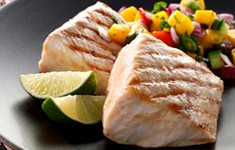
The National Restaurant Association’s “What’s Hot in 2013” culinary forecast, an annual prediction of menu trends for the coming year, has listed, among other things, “non-traditional seafood” as an emerging trend for this year.
That doesn’t come as a surprise to chef Rick Moonen, owner of RM Seafood in the Mandalay Bay casino in Las Vegas. He has made unusual species a staple on the menu in his restaurant for several years. A longtime activist for more responsible fish farming, Moonen has been offering nontraditional species, he said, out of a commitment to sustainable seafood, but he too predicts that new or different species are on the cusp of becoming more mainstream.
“The species that we may think sound weird today will be the norm tomorrow,” he said.
Moonen isn’t opposed to putting traditional seafood on his menu. He offers classic shellfish like shrimp, along with more well-known fish species like salmon, but with the latter, he usually offers the wild product. Many salmon farms, he said, are under so much pressure to produce that they don’t always do it in what he thinks is an ethical or safe manner.
Moonen offers other fish, like Arctic char, which he calls “salmon lite,” for two reasons: to keep fish on the plate when wild varieties are out of season, and to drum up interest in other species, thus giving farmers of traditional species like salmon a chance to catch up with demand.
“If we can just add some more diversity to our diet, we can relieve some of the pressure on those target species,” he said.
There’s a financial benefit, too. Fish that are not well known are not in high demand, Moonen said, which means they will be cheaper. Compare that to species such as bluefin tuna, which are only expected to get more expensive, he said, and restaurateurs will soon embrace the alternatives.
“It’s not so easy to get the fish that they used to get,” he said.
Moonen has offered cobia before, an Atlantic fish that is fatty, sweet and easy to cook. He tells his customers it’s a lot like Chilean sea bass. Barramundi, he said, is another species that could grow more popular in the future. Even steelhead trout, a river fish that rarely makes it into restaurants, could begin appearing.
“I just feel that the timing is right,” he said. “There’s tons of biomass in the ocean.”
Moonen said chefs and restaurant owners should not be afraid of unusual species, even if some diners won’t respond right away.
“It’s difficult to get people out of their habits,” he said.
That’s why it’s important to keep some staples, like shrimp, scallops and lobster, on the menu. Having a variety of options, he said, will entice more adventurous diners, while more conservative ones at the same table will be encouraged to check out something different.
The key, Moonen said, is to maintain that balance between traditional and nontraditional fish. Even RM Seafood menus plenty of recognizable choices for those with a more conventional palate.
“It’s not just a house of weirdness,” he said.





